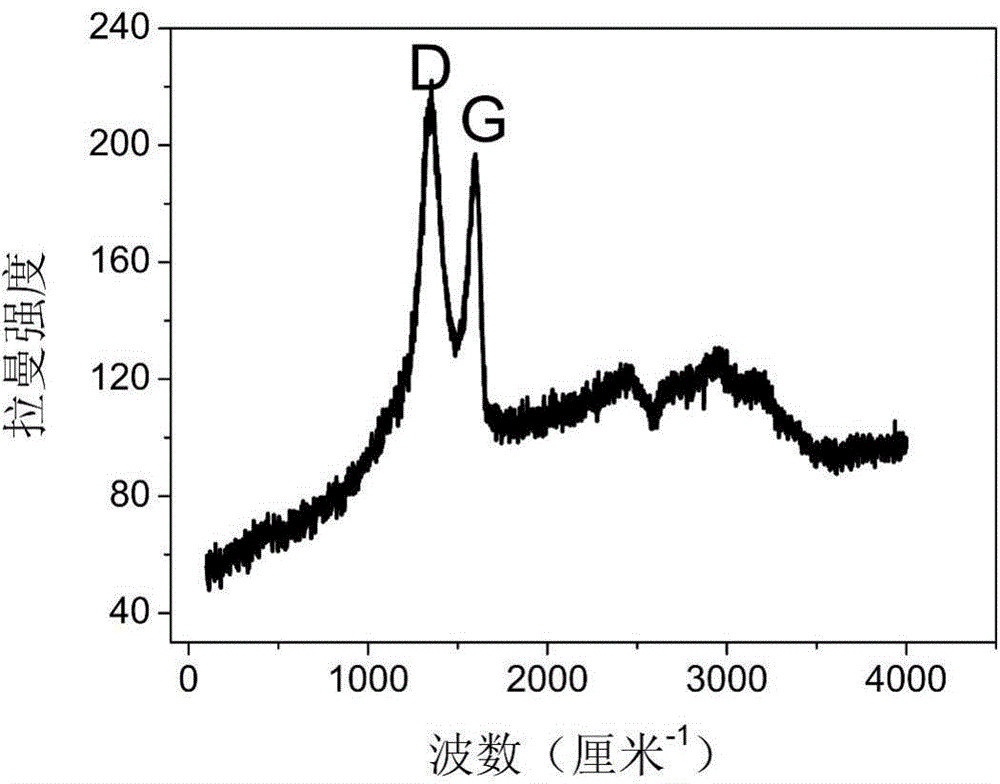High-substrate-affinity graphene-oxide-loaded nano-platinum mimetic peroxidase and preparation method thereof
A technology of peroxidase and graphene, applied in the field of nanotechnology and bionics, can solve the problems of limited application of natural enzymes, limited sources of natural enzymes, harsh storage conditions, etc., and achieve good peroxidase activity and good reproducibility , the effect of low detection limit
- Summary
- Abstract
- Description
- Claims
- Application Information
AI Technical Summary
Problems solved by technology
Method used
Image
Examples
example 1
[0045] Weigh 1.2 g of 325 mesh flake graphite and add it to a mixed solution of 144 mL of concentrated sulfuric acid with a concentration of 18.4 mol / L and 16 mL of phosphoric acid with a concentration of 14.7 mol / L. After stirring well, place in an ice bath at 0 °C. Slowly add 7.2 g of potassium permanganate in small quantities to the above mixed solution for low-temperature intercalation reaction. After keeping the ice bath at 0°C and magnetically stirring for 3 hours, the obtained dark green suspension was transferred to a warm water bath at 35°C for medium-temperature reaction, and the temperature was controlled for 1 hour. The resulting suspension was then transferred to a warm water bath at 50°C for high-temperature deep oxidation, and the temperature was controlled for 12 hours. The obtained purple-black suspension was slowly added to 160 mL ice-water mixture, and stirred vigorously for 1 hour. Then, 4.8 mL of 30wt% hydrogen peroxide solution was added dropwise to the...
example 2
[0047] Add 0.575 mL of chloroplatinic acid aqueous solution with a concentration of 10 mg / mL to 9.225 mL of graphene oxide solution with a concentration of 2 mg / mL, mix vigorously for 15 minutes, then add 0.2 mL of 5 mg / mL Aqueous sodium borohydride solution was magnetically stirred for 4 hours. The nano-platinum aqueous solution obtained under the condition of no graphene oxide is brown, while the aqueous solution of graphene oxide-nano-platinum composite is dark brown (see figure 1 A and B in ). After standing for 120 hours, the nano-platinum solution completely settled, while the graphene oxide-nano-platinum composite aqueous solution still showed good dispersion (see figure 1 C and D in ). Scanning the ultraviolet-visible absorption spectra of nano-platinum and graphene oxide-nano-platinum, the graphene oxide-nano-platinum aqueous solution has a maximum absorption value at 230 nm, while the nano-platinum aqueous solution obtained without graphene oxide does not show an...
example 3
[0049] Add 0.575 mL of chloroplatinic acid aqueous solution with a concentration of 10 mg / mL to 9.225 mL of graphene oxide solution with a concentration of 2 mg / mL, mix vigorously for 15 minutes, then add 0.2 mL of 5 mg / mL Aqueous sodium borohydride solution was magnetically stirred for 4 hours. After the resulting solution was freeze-dried, the resulting powder was characterized by Raman spectroscopy, at 1336 cm -1 and 1593 cm -1 The D peak and G peak of graphene oxide appear at the place (see image 3 ).
PUM
| Property | Measurement | Unit |
|---|---|---|
| Michaelis constant | aaaaa | aaaaa |
| Michaelis constant | aaaaa | aaaaa |
| The average particle size | aaaaa | aaaaa |
Abstract
Description
Claims
Application Information
 Login to View More
Login to View More - R&D
- Intellectual Property
- Life Sciences
- Materials
- Tech Scout
- Unparalleled Data Quality
- Higher Quality Content
- 60% Fewer Hallucinations
Browse by: Latest US Patents, China's latest patents, Technical Efficacy Thesaurus, Application Domain, Technology Topic, Popular Technical Reports.
© 2025 PatSnap. All rights reserved.Legal|Privacy policy|Modern Slavery Act Transparency Statement|Sitemap|About US| Contact US: help@patsnap.com



